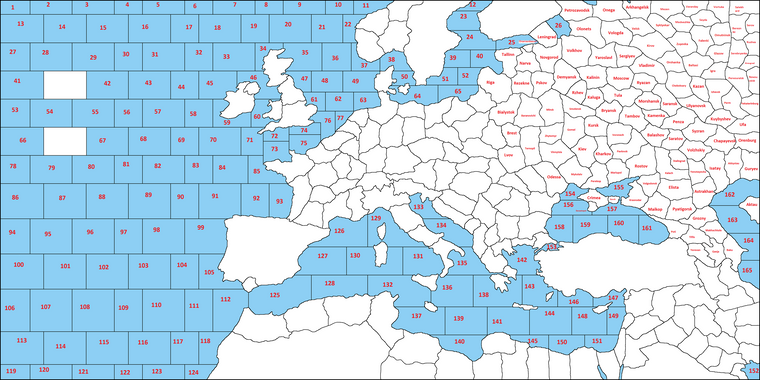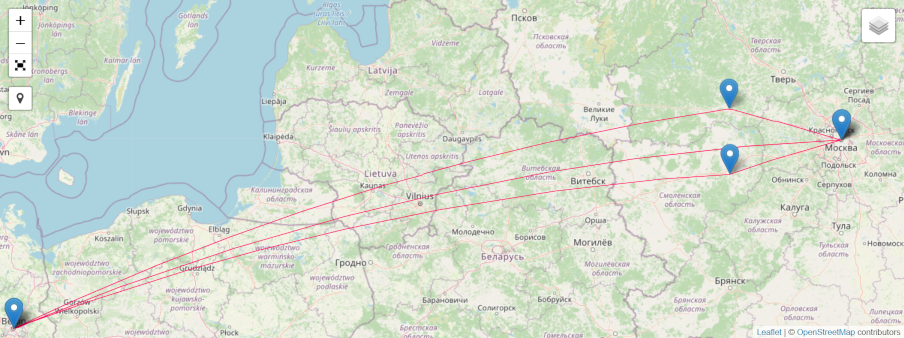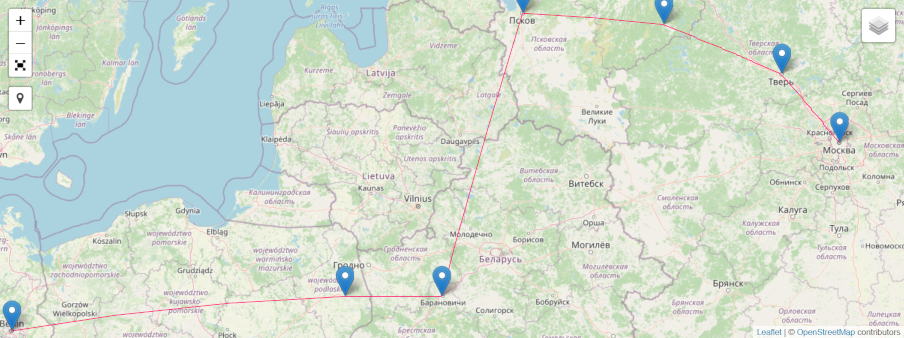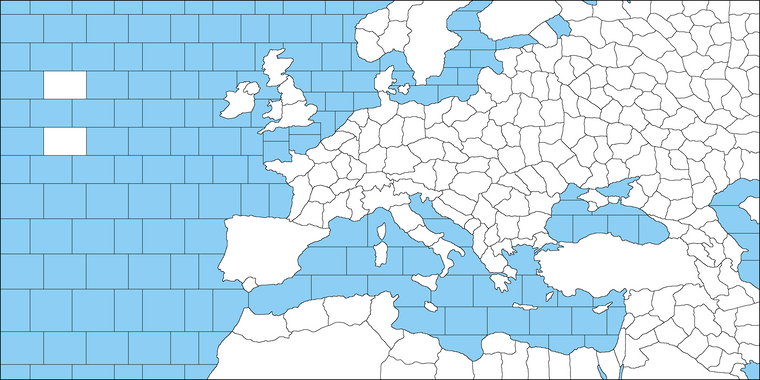Realistic WWII Scenario
-
@cernel Germany was the one who is responsible of Romanian territorial loses during WWII. If Rumanians can fight alongside with the Germans, sure they could fight alongside with Hungarians. I see no reason why wouldn't they exist as a single country. Ideally I would prefer having Finland as 3.rd Axis but its political situation is harder to represent.
-
Is is possible for a nation playing two times in a round? For example;
<step name="GermanyCombatMove" delegate="move" player="Germany"/>
<step name="GermanyPurchase" delegate="purchase" player="Germany"/>
<step name="GermanyBattle" delegate="battle" player="Germany"/>
<step name="GermanyNonCombatMove" delegate="move" player="Germany" display="Non Combat Move"/>
<step name="GermanyPlace" delegate="place" player="Germany"/>
<step name="GermanyEndTurn" delegate="endTurn" player="Germany"/><step name="RussiaCombatMove" delegate="move" player="Russia"/>
<step name="RussiaPurchase" delegate="purchase" player="Russia"/>
<step name="RussiaBattle" delegate="battle" player="Russia"/>
<step name="RussiaNonCombatMove" delegate="move" player="Russia" display="Non Combat Move"/>
<step name="RussiaPlace" delegate="place" player="Russia"/>
<step name="RussiaEndTurn" delegate="endTurn" player="Russia"/><step name="JapanCombatMove" delegate="move" player="Japan"/>
<step name="JapanPurchase" delegate="purchase" player="Japan"/>
<step name="JapanBattle" delegate="battle" player="Japan"/>
<step name="JapanNonCombatMove" delegate="move" player="Japan" display="Non Combat Move"/>
<step name="JapanPlace" delegate="place" player="Japan"/>
<step name="JapanEndTurn" delegate="endTurn" player="Japan"/><step name="BritainCombatMove" delegate="move" player="Britain"/>
<step name="BritainPurchase" delegate="purchase" player="Britain"/>
<step name="BritainBattle" delegate="battle" player="Britain"/>
<step name="BritainNonCombatMove" delegate="move" player="Britain" display="Non Combat Move"/>
<step name="BritainPlace" delegate="place" player="Britain"/>
<step name="BritainEndTurn" delegate="endTurn" player="Britain"/><step name="GermanyCombatMove" delegate="move" player="Germany"/>
<step name="GermanyPurchase" delegate="purchase" player="Germany"/>
<step name="GermanyBattle" delegate="battle" player="Germany"/>
<step name="GermanyNonCombatMove" delegate="move" player="Germany" display="Non Combat Move"/>
<step name="GermanyPlace" delegate="place" player="Germany"/>
<step name="GermanyEndTurn" delegate="endTurn" player="Germany"/>If Germany can play twice in a round, it would be very interesting assymetical advantage to counter Allies income advantage.
-
@schulz I don't like the idea. Regardless, the step name must be different every time: change the "Germany" part in the name to something else in every second instance.
-
@cernel Axis needs some assymetric advantages to offet Allies income advantage.
-
@schulz I have tried to create some kind of double movement for Germany and US but have not been able to get the details of it to my satisfaction. You can have two combat movement and combat phases. But strange things happen with ground movement and air units can attack twice which may not be desirable. You can also have something like "German Air", a player that just controls air units and goes before Germany and punches holes for armor to exploit. But how do you give it more income, or transfer air units between players? And I guess you could just let the Germans move twice per turn but then they are also collecting income twice.
-
@andrewthree I was thinking alternative solutions to reflect reality and giving Axis the higest chance to win.
We could assume that Germany is going total war economy after December 1941, Finland attacks Murmansk railways and Leningrad, Bulgaria declares war on the Soviets, Japan wins battle of Midway hence draws more US resources into Pacific I don't think they would make the game more unrealistic since they are all plausible things. Even if I can totally reflect the reality of spring 1942, I still have no obligation to execute -let's say- Fall Blau just because it happened in reality. I think it should also cover "what could have been happened?"
To give Germany more initiative on the Eastern front, probably I would make German fighters way cheaper than the Soviet ones to reflect German air supremacy until late 1942.
@Cernel actually downgrading real naval movements is a realistic aspect to offset the lack of railroads.
-
@andrewthree Using air power to punch holes is not realistic. Air power weakens the defender, rather than destroying the defender. Given the scale of the game, it makes more sense of air superiority giving advantage, as in the AA1914 game.
-
Any suggestion to rename any of the Soviet cities?

-
@schulz said in Realistic WWII Scenario:
Any suggestion to rename any of the Soviet cities?

I see several things which I believe are wrong.
However, I especially keep seeing a thing that I've already pointed out, yet it is still there.
I assume that the territory called Rzhev is representing the Rzhev - Vyazma salient.
https://en.wikipedia.org/wiki/Operation_Büffel#/media/File:Rschew_Operation_Bueffelbewegung.jpgAs I've already said, latitude-wise, Rzhev is well north of Moscow and Vyazma is about as much south of Moscow as Rzhev is north of it. Thence, the Rzhev territory should be about perfectly vertically aligned with the Moscow territory.
Instead, again, you are having the Moscow territory consistently on a latitude northwards of Rzhev.
This misplacement of the salient is not a trivial matter.
For example, here it is the shortest air path from Berlin to Moscow and also the shortest paths by going through Rzhev and Vyazma respectively:

As you can see, the shortest path from Berlin to Moscow passes between Rzhev and Vyazma: if you want to go from Berlin to Moscow without moving through the Rzhev - Vyazma salient you are making your path so much longer that, on a map of this scope, it would be substantially like moving through one more zone.
Instead, in your drawing, going from Berlin to Moscow through Rzhev - Vyazma (which ought to be THE shortest path) is not even one of the shortest paths!
Starting from the named territories, one of the shortest paths from Berlin to Moscow is currently Bialystok - Baranovichi - Pskov - Demyansk - Kalinin - Moscow.
This is that path for real:

How on earth can this thing be one of the shortest paths from Berlin to Moscow and even shorter than every path going through Rzhev or Vyazma?
The shortest path from Berlin to Moscow is actually 1,610 km, while this tortuous path of yours is a total of 2,022 km and, in your drawing, is even 1 move faster than any path going through the Rzhev - Vyazma salient! Since you got a path which is over 400 km longer than the shortest one in a map where the average territory appears to be about 200 km wide and in which the real world shortest one is one territory longer than the shortest one in the map (actually being over 400 km longer for real), you are off by a total of 3 zones (or about 600 km) on your shortest path compared to what the shortest path should be!
-
@cernel Good catch, I haven't pay attention to this weird and shortest route between Berlin and Moscow. But I am unable to redraw these territories properly because every new drawing disrupts the others. I am more interested in keeping disances realistic as much as possible rather than scaling Rzhev more correctly. Actually merging Rzhev and Demyansk seems solves the issue.
-
@schulz said in Realistic WWII Scenario:
@cernel Good catch, I haven't pay attention to this weird and shortest route between Berlin and Moscow. But I am unable to redraw these territories properly because every new drawing disrupts the others. I am more interested in keeping disances realistic as much as possible rather than scaling Rzhev more correctly.
That is because (as I anticipated) you are not using an equal-area projection. The only way you can have all or most being relatively correct is by taking care having increasingly bigger territories going northwards. For example, you should not move the Moscow territory northwards but keeping it at the right place and just make the territories north of it bigger and the territories south of it smaller, so you have fewer of the former and more of the latter.
Or, preferably, using an equal-area projection.
Actually merging Rzhev and Demyansk seems solves the issue.
On a map of this scope I would rather say Rzhev and Demyansk should not even be adjacent. I suppose you should represent the rather extensive territory between them which the Soviets took in the winter of 1941-2. I would say this is a must if you don't allow for contested territories.
-
@cernel Even if the salient that between Demyansk and Rzhev (which the Soviets took in the winter offensive) represented, the Soviets would be unable to keep the territory without taking Rzhev and lifting the siege of Leningrad unlike what happened in the reality. I don't really want to draw everything from the scratch. I think its better trade off ignoring the Soviet salient in sake of correcting Berlin-Rzhev-Moscow route if needed. Here is an alternative;

-
@schulz
I dont envy your task.As this scale the map areas should be a mix of geographical and political territories as you have done for the UK.
How are going to cope with the massive area of the Pripet/Pinsk Marshes as they cover 300x140 miles, personally I think they should be split into smaller areas to represent the slow going.
Also, the mountain areas especially around Croatia and Bosnia, Greek peninsula should be smaller, that is halved. The arc of the Carpathian mountains should also have their own territories. Mountain troops will then have a role/bonus. Motorised will be relegated to the mountain passes.
In TripleA terms these smaller areas only need to hold 4-5 units before they overflow.
-
@thedog I intended to keep all territories in similar size as much as possible while considering historical advancements and political boundaries only. Territory effects can be implemented but I am also planning to make the Soviets AI controlled to offset Allies historical advantages, territory effects might be too much for AI to handle it.
-
@schulz said in Realistic WWII Scenario:
@cernel Even if the salient that between Demyansk and Rzhev (which the Soviets took in the winter offensive) represented, the Soviets would be unable to keep the territory without taking Rzhev and lifting the siege of Leningrad unlike what happened in the reality. I don't really want to draw everything from the scratch. I think its better trade off ignoring the Soviet salient in sake of correcting Berlin-Rzhev-Moscow route if needed. Here is an alternative;

I definitively think it would be a miss for a map of this scope not to represent the extensive Soviet-held territories west of Rzhev. I don't believe that your argument (that no player would ever go there that way) is an excuse for it, and it certainly is not if the game starts after January 1942, because that is already the frontline (whether or not any player would have done such a thing) unless you represent the situation by making a territory contested.
https://en.wikipedia.org/wiki/Battle_of_Rzhev,_summer_1942#/media/File:Rschew_1942.jpg
I'm thinking that the two most important distances for World War 2 are Berlin - Moscow and Berlin - Baku. That is because Berlin is the capital of Germany and Moscow and Baku are arguably the two most important objectives of Germany.
Berlin - Moscow is 1610 km.
Berlin - Baku (by land) is 3072 km.This is also, alas, one of the most tipycal distancing which TripleA games get wrong by large.
From Germany, WWII Classic requires 3 moves to reach either.
Europe keeps the parity, at 4 moves to reach either.
WWII Revised is even worse (!), requiring 4 moves to reach Moscow and 3 moves to reach Baku. The same for v4 and v5, as well as Pact of Steel.
WWII v3 is less worse than Revised at least, requiring 4 moves to reach either.
WWII Global is the first game which aknowledges that Baku is at least farther away, requiring 5 moves to reach Moscow and 6 moves to reach Baku (Fun fact: going up north through the Baltic States is one of the fastest routes from Germany to the Caucasus!). Still, this is not very good, as here Baku is only a bit farther away, whereas it should be much farther away.
World At War is an other not very good example, requiring 8 moves from Berlin to Moscow and 9 moves from Berlin to Azerbaijan (which starts as a Neutral territory, so maybe that was somehow supposed to be Iranian Azerbaijan...).
New Word Order is about the same, at 9 and 10 moves, respectively (but at least there "Azerbaydzhan" is Russian).
Same story for Total World War: 7 and 8, respectively.
Big World is worse than every aforementioned big map: 5 moves to reach either (like in WWII v3 but with 1 more space for both).I surmise this is really more a consequence of the projections, making the world bigger and bigger as you go north from the equator (the most extreme example being the Mercator projection).
Your current drawing requires 9 movements to reach Moscow from Berlin (exactly the same as New World Order). Realistically, this would imply that reaching Baku from Berlin should require about 17 moves. I counted 15, which is pretty close and makes your map much better than anything on which the community is currently playing, as far as I know.

-
@cernel The Soviet-held territories west of Rzhev is represented but due to it is location (between German army group North and Center) it would be impossible for the Soviets to keep this territory unless they could take both Rzhev and Novgorod. Any suggestion to make this territory not doomed to fall the Germans very easily?
-
@schulz said in Realistic WWII Scenario:
@cernel The Soviet-held territories west of Rzhev is represented but due to it is location (between German army group North and Center) it would be impossible for the Soviets to keep this territory unless they could take both Rzhev and Novgorod. Any suggestion to make this territory not doomed to fall the Germans very easily?
It's not just this case. Generally speaking, the usual TripleA warfare in WW2 maps is more akin to Napoleonic warfare than period warfare. You have this extreme tendency to stack your force in a single location for a single massive battle (or the menace of it), instead of dispersing your forces to hold the whole frontline, as it was almost always the case. This is mostly due to two factors:
- The usual games underestimate the advantage of the defence (and this could be fixed by having infantry at offence/defence 1/4 instead of 1/2, or something like that).
- The usual games have infinite rounds for battles (meaning that, practically, all battles happen in no time) and no ability for the defenders to reinforce after the battle starts but before the battle is over (and this could be fixed by having limited combat rounds and low power to dice-sides).
Regarding the matter at hand, the zone around Novgorod was very much akin to the Pripyat marshes: in many places it was virtually impossible for mechanized units (even light armours) to operate. This, of course, slowed down military operations and allowed the Sovietics to capitalize on their superiority in horse cavalry. Often whole offensive operations were carried out without using any armours. By the way, the actual penetration of the Sovietics in the sector in question was far in excess of what most maps show, reaching even south of Smolensk, but it was a very fluid situation of mostly horseback raiding aided by partisan warfare (better represented by allowing for contested territories).
https://en.wikipedia.org/wiki/Pavel_BelovPavel Alexeyevich Belov (Russian: Павел Алексеевич Белов; 18 February 1897 – 3 December 1963) was a Soviet Army colonel general and a Hero of the Soviet Union. He was nicknamed the "Fox" by the Germans, and personally led the longest successful raid of the war, lasting five months behind the German lines.
The winter of 1941-1942 was extremely severe. Mean temperatures near Moscow during January 1942 were -32 °F or -35 °C with the lowest temperature recorded on 26 January 1941 -63 °F/-52 °C. In the counterattack and the general offensive of Soviet troops in the western direction, the 1st Guards Cavalry Corps under the command of Belov distinguished himself more than once in battles: after the Rzhev-Vyazma operation (1942), being surrounded, he fought in the enemy’s rear for more than five months. Belov’s 1st Guards Cavalry Corps along with the 33rd Army controlled a pocket from south of Smolensk-Vyazma in size of 2 500 km²/1 553 mile² area. In his pocket, Belov mustered 2000 men from the cavalry, partisans, paratroopers, and riflemen, supported by a battalion of eight tanks including one KV heavy and one T-34 medium tank.
On June 16, General Franz Halder, head of the OKH, wrote in his operations diary:
"Cav Corps Belov has again broken out and is moving in the direction of Kirov. Nothing we could brag about. Cav Corps Belov is now floating around the area west of Kirov. Quite a man, that we have to send no less than seven divisions after him."(The Kirov which is being mentioned is, of course, not ex-Vyatka, but a less important city: a small town formerly named Pesochnya, which is located between Bryansk and Vyazma.)
-
-
I think the issue is combination of unlimited stacking ability and defense's relative lack of historical strength. Making defensive units way stronger would force players spamming almost only infantry type units which wouldn't require much skill.
-
My opinion would be either making defense only slighly stronger (like inf=30, art=45 arm=60) and limiting stacks. Or making infantry types of units really good at defense (like 1/3 or 1/4) but keeping their upkeeps really high to make other units more viable.
-
-
@cernel said in Realistic WWII Scenario:
Generally speaking, the usual TripleA warfare in WW2 maps is more akin to Napoleonic warfare than period warfare. You have this extreme tendency to stack your force in a single location for a single massive battle (or the menace of it), instead of dispersing your forces to hold the whole frontline, as it was almost always the case. This is mostly due to two factors:
- The usual games underestimate the advantage of the defence (and this could be fixed by having infantry at offence/defence 1/4 instead of 1/2, or something like that).
- The usual games have infinite rounds for battles (meaning that, practically, all battles happen in no time) and no ability for the defenders to reinforce after the battle starts but before the battle is over (and this could be fixed by having limited combat rounds and low power to dice-sides).
Yes! I was beginning to wonder if I was the only person who feels this way.
-
@schulz stacking limits and limited rounds would help.